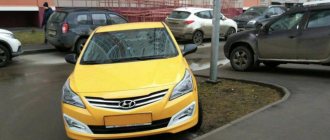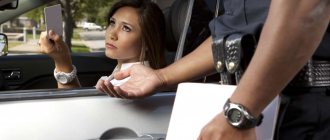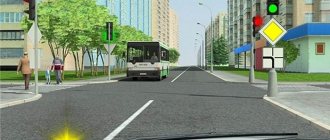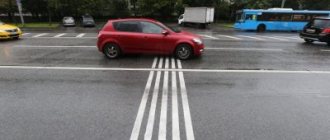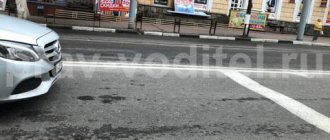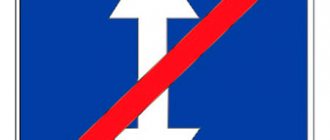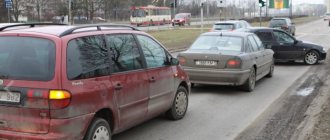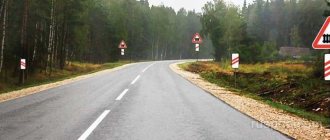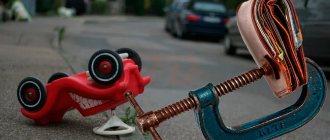What does a blue traffic light mean on a railway? | Topic author: Artyom
Oleg There are two signals at shunting traffic lights: Blue - prohibits maneuvers, White - allows.
At shunting traffic lights, such colors are used so that drivers of other trains do not confuse them with other traffic lights, since their indications concern only drivers performing shunting work.
Eduard It seems that the switches are not being made now.
Valentin As you know, the railway uses Leonid shunting traffic lights, the blue signal of which prohibits maneuvers
Vadim
Konstantin is prohibited from performing maneuvers
Dima A very difficult death is coming to you! At a speed of 80 km/h
Valery, a blue traffic light on the railway means - atas cops, smile at everyone!
Boris “Maneuvers are prohibited”
Why do Japanese traffic lights need a blue signal?
The green color of a traffic light in Japan is called "ao shingu", which translates to "blue signal". The reason for this “confusion” was the peculiarities of the language.
Background Many centuries ago, in the Japanese language, green had the same name as blue - “ao”. This linguistic feature has not gone away today, but even the Japanese themselves do not always understand why and how it arose. Some believe that this shade is associated with everything fresh and new, which is why even grass and unripe apples are called blue.
However, the green color has its own name - "midori", which is translated from Japanese as "escape" or "sprout". The new word appeared already in the 11th century, but many people, out of habit, continued to use the old name "ao". Because of this, at the time of the installation of the first traffic lights in Japan, the word “ao” was indicated in all official documents regulating their installation. Such confusion led to the fact that for several years in a row on the roads in the Land of the Rising Sun one could see colors that were unusual for a European person.
Decided to stand out In November 1968, most countries adopted the Vienna Convention on Road Signs and Signals. This obligated the governments of the states that adopted the convention to comply with international standards when installing various road signs and devices. Japan refused to change the standards familiar to its citizens and became the only country that did not want to obey the general rules.
Compromise 5 years later, in 1973, the Japanese government came to the conclusion that the blue signal, unlike the green one, is much less visible from afar. This could cause dangerous situations on the roads, so the old lenses gradually began to be replaced with new ones. Thanks to this decision, Japan's roads became fully compliant with the Vienna Convention.
At the same time, the government did not want to radically change the type of traffic lights familiar to its citizens. Therefore, a compromise was found that allowed them to meet international standards without giving up the characteristics of their culture. To achieve this, road services began to use lenses whose shade was as close to blue as possible. Since then, even in official documents their color has become “midori”.
“Blue signal” Despite the fact that Japan replaced the lenses in all traffic lights more than 40 years ago, local residents still use the familiar expression “ao shingu”. It is difficult for Europeans to understand how the name of another can be used to refer to one color, but this is an integral part of Japanese culture. Therefore, even people born after 1973 still use the old expression without noticing anything unusual in it.
Now, having arrived in Japan, you will definitely not be surprised when you hear how locals call the traffic light signal with the strange phrase “ao shingu”, and not the logical “midori shingu”. Besides, you'll want to understand how the language confusion came about rather than trying to convince the Japanese that they're wrong.
(Visited 16 times, 1 visits today)
You may also like:
Why are there blue traffic lights on the railway? | Topic author: Stepan
Denis
Railway traffic lights actually use not only the usual red, yellow and green colors, but also moon white and blue
The white-blue traffic light belongs to the shunting category. That is, the lunar-white light allows Egor maneuvers, and the blue light prohibits. In some cases, a shunting train is even allowed to pass through front lights if the moon-white light of the shunting traffic light is turned on. That is, a train cannot go to another station, but it is possible to go outside its own station to move or reconnect cars.
By the way, in addition to shunting stations on the railway, there are also entrance, exit, route, checkpoint, barrier, warning, repeat, locomotive, hump and cover traffic lights. They use the same five colors in different combinations.
Yuri The white-blue traffic light belongs to the shunting category: the moon-white light, for example, allows you to recouple cars, serve them for cargo operations, etc., and the blue one prohibits this.
Andrey According to the alarm instructions. All meanings of blue fire can be found here.
What does the traffic light closed mean?
In signaling related to train movement and shunting operations, the main signal colors are used - green, yellow, red, moon-white and blue.
Meanings of traffic lights:
“traffic light is closed” - the red or blue light is on at the traffic light;
“traffic light is open” - the traffic light has a green, yellow, moon-white light or a combination of them on (continuously or in flashing mode).
Extinguished signal lights of traffic lights (except for warning lights in sections not equipped with automatic batteries, barriers and repeaters) , their incomprehensible indication, as well as incomprehensible signaling by other signal devices require stopping the train.
2. The following should not be in the visibility zone of signals: objects and structures, including lights of all colors, that interfere with the perception of signals and distort signal readings.
3. are used as permanent signaling devices .
4. Red, yellow and green signal lights of entrance, warning, passage, barrier and cover traffic lights on straight sections of the route must be clearly visible day and night at a distance of at least 1000 m , in curved sections of the track at least 400 m , in very rough terrain at least 200 m .
The indications of the exit and route traffic lights of the main routes must be clearly visible at a distance of at least 400 m, the exit and route traffic lights of side tracks, invitation signals and shunting traffic lights - at a distance of at least 200 m , and the indications of route signs - at a distance of at least 100 m .
5. must be installed in front of all entrance and passage traffic lights and traffic lights .
Warning traffic lights are not installed - in front of entrance traffic lights from the wrong path and in front of entrance traffic lights in areas where ALSN is used as an independent means of signaling and technological telecommunications.
Lines with particularly heavy traffic of passenger and commuter trains are equipped with automatic batteries with four-digit signaling.
Traffic light at a railway crossing
In order to somehow regulate traffic and prevent emergency situations at crossings, responsible organizations install the necessary equipment for them, which warns of the danger of traffic and blocks violators, preventing them from leaving the tracks when a train is approaching.
A less radical method is a traffic light, which simply signals that traffic is prohibited, but non-compliance with its signals is punishable.
At what crossings are they installed?
Traffic lights are installed at crossings that do not have sufficient visibility in both directions, while the traffic of both trains and cars is quite intense, and the trains themselves move at a very high speed.
In most cases, traffic lights are installed at crossings where there is an automatic control system that does not require the presence of an attendant.
Therefore, if, for example, a crossing is located in a place where the roadway is not visible for a sufficient distance, it is located on a bend in the road, and there is also a high traffic intensity, then an indicating device should be installed in such an area.
What does the signal indicate?
Drivers must understand what the signals that are installed at crossings mean in order to adequately assess the situation and take the necessary measures to avoid an accident.
There is a difference in the operation of automobile and crossing traffic lights, since the mode of operation, the number of colors used in the device and other nuances are different.
Therefore, by understanding what information a traffic light carries, you can figure out when you can move and when it is strictly prohibited and can lead to an accident.
White-lunar
The white-lunar traffic light signal is interpreted differently and drivers often ask what the white-lunar traffic light at a railway crossing means, at the same time, the Rules of the Road have a common understanding of this color.
The fact is that the white-moon signal is not always installed, but only where appropriate, and informs drivers that movement is permitted.
If such an indication is provided, and it is installed between two red prohibition lights, then only its operation allows movement through the crossing.
But it is not always present, and you need to take into account that in its absence you need to focus only on other signals.
White-moon light is often perceived by drivers as a reflection of the functionality of the traffic light, but this information should not worry motorists, since the correct setting and operation of the traffic light is the concern of the relevant services.
Photo: blue color prohibits shunting work
Flashing
Despite the fact that on highways a flashing signal is used, which informs that the current color will soon be switched to another, this is not provided for at crossing traffic lights.
For the fine for overtaking at a railway crossing, see the article: fine for overtaking at a railway crossing. Read here what to do in case of an accident at railway crossings in Russia.
The fact is that both the prohibiting and permissive signals blink, thus attracting more attention from drivers, and the blinking does not convey any additional information, except that the traffic light is operating normally.
Red light
A red signal, as in most other cases, is prohibited and means that the driver is not allowed to move through the crossing.
Such a signal is turned on in advance, and is usually accompanied by sound effects that additionally inform about the impossibility of movement.
Having seen the red signal, the driver must either complete the maneuver or stop in front of the stop line, if one is provided; if there is none, then the distance should be visually determined at 10 meters from the road surface.
When the train has passed, do not rush to go if the traffic light is still working, because another train may pass, which is often the case on busy routes.
Other colors
There are no other colors in the traffic lights that serve railway crossings and inform drivers, but in the semaphores that serve drivers, there are also green, orange and blue colors, which indicate the ability to make maneuvers, the permissible speed and other nuances.
You need to focus exclusively on the device for motorists, following all its instructions.
Photo: other light signals
How does a semaphore work?
The traffic light at a railway crossing can be fully automatic, eliminating the option of being controlled by the crossing officer using a button.
In this case, the train crosses a certain mark, for example a switch, which sends an electrical impulse to the warning system, which closes the barrier and activates the traffic light.
When the passage is complete, the arrow fires again and the passage opens. There are also manual crossings, where the barrier, traffic light and sound indication are activated using a button, and the worker himself learns about the approach of the train via intercom, schedule and directly when the train itself is visible.
Travel rules
In order to prevent violations when moving along a railway crossing, you need to familiarize yourself with some rules of conduct at it related to the presence or absence of special devices.
Such skills are instilled in driving schools, but since very little time is often devoted to such knowledge, the driver is not ready to overcome crossings.
But everything is extremely simple, and you need to follow at least general recommendations, which state that if there are limiting or signaling devices, you need to rely on their condition, and we are talking about an unregulated area, then you should follow the rules of caution.
With traffic light
Since traffic lights are used at the busiest crossings, their importance is extremely high, because alternately flashing signals attract the attention of drivers, and therefore effectively inform them of an approaching train.
When approaching a crossing, the driver must note for himself what state the traffic light is in; if the white-moon light is on, then passage is possible, and if there is none, but the red lights are not activated, then again, passage is possible.
When the red lights turn on, drivers who are at the crossing must clear it, and motorists who are in the safe zone in front of it must stop completely and wait for the train to pass.
Only after this, when the traffic light turns off, will it be possible to continue driving, not forgetting to assess the situation in both directions.
Traffic lights (traffic rules clause 6)
- home
- Educational process
- Traffic lights (traffic rules clause 6)
And we remember that:
- green signal allows movement;
- green flashing allows movement and informs that a prohibitory signal will soon be turned on;
- a yellow signal prohibits movement, but drivers who, when this traffic light turns on, cannot stop without resorting to emergency braking, can continue driving;
- A yellow flashing traffic light permits movement and informs about the presence of an uncontrolled intersection or pedestrian crossing. transition, and also warns of danger;
- red signal , including flashing, prohibits movement;
- a combination of yellow and red prohibits movement and indicates the imminent appearance of a green traffic light.
What kind of traffic lights are there?
1. Traffic lights may have one or two additional sections with arrow-shaped signals. It must be remembered that the effect of traffic light signals in the form of arrows extends to the direction in which these arrows point. If the traffic light of an additional section is turned off or the red light on it is on, it means that you cannot drive in the direction regulated by this section!
2. Reversing traffic lights. They regulate the movement of vehicles in lanes, where the direction of movement can change to the opposite. An X-shaped red signal at such traffic lights prohibits movement in the lane, a green arrow allows it, and a yellow one indicates that you need to immediately change lanes, because the signal is about to change. When the reverse traffic lights are turned off above the lane marked on both sides with markings 1.9, entry into this lane is prohibited!
3. For the movement of route vehicles moving along the lane allocated for them, T-shaped traffic lights of white and moon color can be used. Such a traffic light allows movement when the lower signal and one (or several) upper ones are turned on at the same time. Wherein:
— the combination of the lower and upper left signal allows you to move left
— the combination of the lower and upper right signal allows you to move to the right
— when the lower and middle upper signal turns on, we go straight.
!!! If only the top three signals are on, then movement is prohibited
4. For pedestrians and cyclists. The signals of such traffic lights are made in the form of a man (bicycle). Their effect extends to pedestrians (cyclists).
5. Round white-lunar flashing signal located on the railway. crossing, allows the movement of vehicles through the crossing. If this traffic light is turned off or has a red signal, then we can pass if there are no trains (locomotives, railcars) approaching the crossing within sight.
O.S.
Driving schools in Arkhangelsk "Master-U"
The pleasure of movement!
